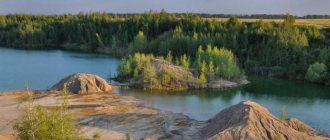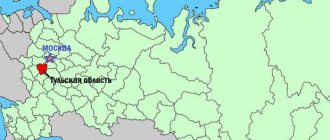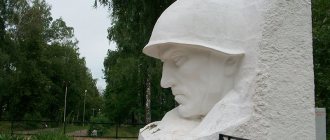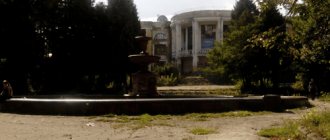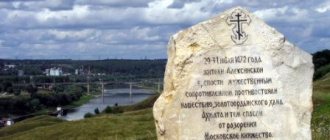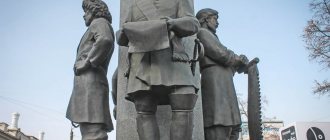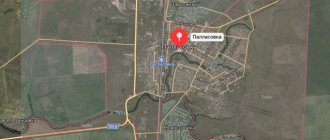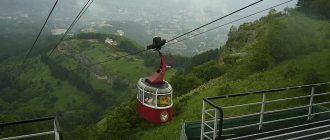Today is a gulbari from the “Sloboda” correspondent Dmitry Zakharyin.
— We will talk about the city of Uzlovaya, which owes its name to the local railway station.
Uzlovaya is my city, it’s the only one! Both you and I love him very much! We have many memorable places in our city. Hurry up and go on the road with me!
Early in the spring morning, Myslo correspondents went to the east of the Tula region to explore the beauty of a town with a population of 53 thousand people, the drive to which turned out to be just under an hour.
I admit honestly that my first meetings with Uzlova date back to the last decade, but then the purpose of the visit was more targeted than historically reference.
Therefore, I devoted the entire 47 minutes of the journey to my destination to drawing up a route that, at the end of the day, would give me an idea of the city where trains have rumbled tirelessly for more than 100 years.
Nodal
(Tula region)
OKATO code:
70244501
Founded:
1873
Urban settlement since:
1926
City since:
1938 City of district subordination (Uzlovsky district, Tula region)
Center:
Uzlovsky district
The city was formerly called:
| Khrushchevskaya | 1873 | 1877 |
| Telephone code (reference phone) | |
| 48731***** | 60-909 |
Deviation from Moscow time, hours:
0
Geographic latitude:
53°59′
Geographic longitude:
38°10′
Altitude above sea level, meters:
220 Sunrise and sunset times in the city of Uzlovaya
Uzlovaya on the map of Russia: geography, nature and climate
A satellite map of Uzlova shows its location on the Central Russian Upland . Belongs to the Central Federal District. The city is located 235 km from Moscow and 45 km from Tula. The Don River flows along the eastern border of the city .
In the vicinity of Uzlovaya there are many deciduous forests - mainly oak, aspen, and birch. The forests of the Tula region are included in the state forest fund of the country and perform sanitary and health functions.
The climate in Uzlovaya is moderate continental. Winters here are moderately cold with frequent thaws. The average temperature is 10 °C. Summer is warm but rainy. The average temperature in July is +23 °C. There is a meteorological station in the city.
Map
| Uzlovaya: maps |
Uzlovaya: photo from space (Google Maps) Uzlovaya: photo from space (Microsoft Virtual Earth)
| Nodal. Nearest cities. Distances in km. on the map (in brackets along roads) + direction. Using the hyperlink in the distance , you can get the route (information courtesy of the AutoTransInfo website) | |||
| 1 | Dubovka | 7 () | SW |
| 2 | Donskoy | 9 (10) | IN |
| 3 | Novomoskovsk | 9 (8) | IN |
| 4 | Kireevsk | 16 (25) | Z |
| 5 | Gritsovsky | 17 (19) | WITH |
| 6 | Borodinsky | 22 (41) | Z |
| 7 | Kimovsk | 24 (25) | IN |
| 8 | Bogoroditsk | 24 (29) | YU |
| 9 | Bolokhovo | 25 (29) | NW |
| 10 | Lipki | 30 (46) | Z |
| 11 | Tovarkovsky | 33 (41) | YU |
| 12 | Sovetsk | 35 (53) | Z |
| 13 | Venev | 41 (50) | WITH |
| 14 | Pervomaisky | 42 () | Z |
| 15 | Shchyokino | 42 (56) | Z |
| 16 | Tula | 43 (44) | NW |
| 17 | Plekhanovo | 48 () | NW |
| 18 | Volovo | 48 (65) | YU |
| 19 | Oktyabrsky (Ryazan region) | 55 () | NE |
| 20 | Warm | 55 (66) | SW |
| 21 | Leninist | 56 (59) | NW |
| 22 | Mikhailov | 62 (75) | NE |
| 23 | Yasnogorsk | 63 (81) | NW |
| 24 | Serebryanye Prudy (Moscow region) | 64 (80) | NE |
| 25 | Plavsk | 65 (86) | SW |
| 26 | Kurkino | 69 (87) | SE |
| 27 | Dubna | 81 (91) | Z |
| 28 | Zakharovo (Ryazan region) | 84 (100) | NE |
| 29 | Arkhangelskoe | 85 () | YU |
| 30 | Aleksin | 91 (100) | NW |
a brief description of
The city is located 54 km southeast of Tula. Railway node
Territory (sq. km): 33
Information about the city of Uzlovaya on the Russian Wikipedia site
Historical sketch
Founded in 1873 as a railway junction. Khrushchevskaya station. In 1877 it was renamed Uzlovaya. The name reflects the station's position in the railway junction. In 1916, construction of the railway began from Uzlovaya. lines to Venev - Moscow.
District center since 1924. Workers' village of Uzlovaya since February 22, 1926. In 1932-35. Uzlovaya is one of the centers for the construction of the Moscow-Donbass railway.
In 1938, the first mine was founded in Uzlovaya, and the second in 1942.
The city since 1938. Until 1957, part of the Moscow region.
During the Great Patriotic War of 1941-45, the city was occupied by Nazi troops on November 21, 1941. It was liberated on December 14, 1941 by troops of the Western Front during the Tula operation.
In 1942-58. 15 mines were built in Uzlovaya, and 5 mining settlements arose.
Economy
PA "Crane" (founded in 1946; production of mechanized complexes for coal mining, bridge and container cranes), "Plastik" (since 1959), yeast plant, clothing and shoe factories, food industry enterprises.
Brown coal mining (since 1938).
Main enterprises
COAL MINING
Mine "Dubovskaya" OJSC "Tulaugol"
301650, Tula region, Uzlovsky district, Uzlovaya,
Offers:
coal
CHEMICAL INDUSTRY
JSC "Plastic"
301650, Tula region, Uzlovsky district, Uzlovaya, st.
Tulskaya, 1 Offers:
styrene, ABS plastic, polystyrene, phenolic plastics, wallpaper, consumer goods made of plastic
MECHANICAL ENGINEERING
OJSC Uzlovsky Machine-Building Plant named after.
I.I. Feduntsa 'Crane'" 301650, Tula region, Uzlovsky district, Uzlovaya, st.
Zavodskaya, 1 Offers:
electric gantry and bridge cranes, complexes and powered supports, conveyors
RADIO INDUSTRY
OJSC "Long-Range Communication Equipment"
301650, Tula region, Uzlovsky district, Uzlovaya, st.
Dubovskaya, 2 Offers:
communication equipment
Culture, science, education
Art Gallery.
Museums, galleries, exhibition halls
Uzlovsky Art and Local Lore Museum 301600, Tula region, Uzlovsky district, Uzlovaya, st. Beklemishcheva, 48 Phone(s): (48731) 6-34-04
| Population by year (thousands of inhabitants) | |||||||
| 1926 | 3 | 1979 | 64.8 | 2003 | 59.8 | 2014 | 53.3 |
| 1931 | 5.9 | 1982 | 64 | 2005 | 58.1 | 2015 | 52.8 |
| 1939 | 17.9 | 1986 | 64 | 2006 | 57.4 | 2016 | 52.4 |
| 1959 | 53.9 | 1989 | 64.9 | 2007 | 56.9 | 2017 | 51.9 |
| 1962 | 53 | 1992 | 63.6 | 2008 | 56.4 | 2018 | 51.4 |
| 1967 | 52 | 1996 | 62.2 | 2010 | 55.6 | 2019 | 50.5 |
| 1970 | 61.9 | 1998 | 61.0 | 2011 | 55.3 | 2020 | 49.7 |
| 1973 | 64 | 2000 | 59.8 | 2012 | 54.5 | 2021 | 49.2 |
| 1976 | 64 | 2001 | 59.0 | 2013 | 53.9 | ||
Nodal center of the Tula region. How Uzlovaya lived and developed
Train station and fun markets
The city owes its birth to the construction of the Syzran-Vyazma railway in 1873. This is how the Khrushchevskaya 2nd class station arose there. Since 1877, the station began to be called Uzlovaya. In 1924, it became the regional center of the Uzlovsky district of the Bogoroditsky district of the Tula province. In 1926 it became a workers’ settlement, and on September 11, 1938, Uzlova was given the status of a city.
“There are two big stops in the Tula province: Uzlovaya and Tula itself,” former governor M. Osorgin recalled the days of his arrival in Tula.
Staraya Uzlovaya was a railway junction with four-way traffic - to Tula, to Epifan, to Efremov, to Venev. The station had a locomotive depot, railway workshops for medium repairs of locomotives and carriages, a water pumping station, oil storage facilities, a fuel warehouse and a large grain elevator. There were no other industrial enterprises. There were also two large warehouses for cargo. The village at the station consisted exclusively of private houses of railway workers, stretching along the street from the station to the villages of Voeikovo and Sviridovo.
Only the railway authorities and the most qualified railway employees and workers, for example, service chiefs and locomotive drivers, lived in one-story wooden and two-story (brick bottom, wooden top) government houses, built in line with the railway station on both sides.
In the space between the railway school and the elevator there was a railway hospital, good for those times, with one two-story and two one-story wooden buildings. They have a residential building for doctors.
Behind the station there is a small square; the center of the village was built up on different sides with benches and stores. Here was the only two-story building in Uzlovaya - the hotel of the merchant Chesnokov. On this square on holidays there were cheerful markets - fruits, honey, flour, cereals, hay.
Guests from Ukraine in Uzlovaya. 1958
The work of a railway employee in those days was full of hassle and danger. Special responsibility lies with the station duty officer. He was responsible for everything. It is enough not to notice the incorrect position of the input arrow or the slightest deviation from the rules for a catastrophe to occur. For example, forgetting to give the driver a warning about driving quietly in a dangerous place or not recording a travel dispatch. All the work of the duty officers was a complete hassle and took place in incredibly difficult conditions, under which it was impossible to do without violating the rules of technical operation.
The compilers and couplers, who were generally called buffer meat, had no less intense work. Very often they became victims of accidents, because train maneuvers were almost always carried out at night, in poor light, when snow flakes covered their eyes or their feet slipped on wet sleepers.
But the people who worked there were amazing. One of them is the father of the future creator of the Russian atomic bomb, the famous Stalinist People's Commissar Abraham Zavenyagin. At the age of seventeen, he left the village and entered the Protopopovo station - present-day Plekhanovo - as a laborer. Then he moved to the newly opened Uzlovaya station, where he lived almost until the end of his life. He never drank or smoked, was scrupulously honest, did not tolerate meanness and sloppiness.
The famous People's Commissar Abraham Zavenyagin, born in Uzlovaya.
The Zavenyagin family occupied a good two-room apartment for those times, with a large kitchen, in a two-story house. The house had a good closet, a shed and a cellar filled with ice. The Zavenyagins lived first to the left of the station, opposite the upper depot, and then to the right of the station, opposite the water pump, four houses from the railway school. The railway tracks started right from the house, no further than ten to fifteen meters.
“In those distant childhood times, walking beyond the railway line was our favorite pastime,” recalled Ivan Zavenyagin. – During free time from studying, 5-10 people walked around. We went beyond the line in the morning, when with our girlfriends, and more often without them, we spent the whole day here in games, fun and songs. We collected flowers and the girls made wreaths from them.
There were also four decent orchards of local merchants in Uzlovaya. Fascinated by the apples and pears hanging on the branches, we children sometimes looked there, despite the strict prohibition of our parents. They got caught and got a beating from their parents.
There was a similar incident with eight-year-old Avranya. He climbed into the garden rented by the bailiff. Sister Maria stood guard. But she overlooked the owner of the garden, and her little brother ended up in the tenacious hands of the police officer. Showing imaginary submission to fate, he relaxed the tenacity of the guard’s hands, and then rushed and was gone.”
There were no rivers or decent lakes in the vicinity of Uzlovaya. To the right of the station, two kilometers away, the Lyubovka River flowed. It was blocked by a dam. The result was a large flowing pond. From here the Knotska railway water pump supplied steam locomotives and part of the railway houses with water.
Honor guard at the monument in honor of the 30th anniversary of the Victory.
The elder brother Ivan recalled how Abraham told him three years before his death:
– Our father is a kind of nugget. Keep this in mind. He had a minimal education - two classes at a rural school, but relatively quickly achieved the qualifications of a first-class machinist. He sincerely welcomed everything new that came into life and improved human life.
Having acquired a large family, the father considered himself morally obligated to provide each of his children with an education. This was expensive, so the parents observed strict frugality in their family expenses. “In childhood, this frugality was incomprehensible to us children,” recalled son Ivan. “We thought it was stingy on her father’s part.” They teased the mother, forcing her to overspend the limit set by the father, and hence the father and mother often had conflicts, which usually ended in the mother’s tears.”
At the same time, all children received an education. Abraham in 1912 went to study in Skopin, Ryazan province, at a real school. In the fifth grade, he became interested in catching siskins; it was a widespread passion then. I started skipping classes and got bad grades. The school management signaled to my father, and he immediately left for Skopin.
Abraham later said:
“If my father had begun to discipline me with his usual severity, then I might not have given up catching siskins.” But he just told me: “It’s not good, Avranya, to treat your studies this way. I hope you yourself will understand this and part with the siskins. I trust your discretion." Then he gave me money for small expenses and left. But I felt ashamed in front of my father, and I seriously took up my studies.
Teenager Samsonov
“Uzlovsk, like many county towns in Russia at the end of the nineteenth century, arose around a large railway station, approximately halfway between Moscow and Ensk, and therefore it was the station, and with it all its main services - the station, depot, auxiliary buildings - that represented the economic and spiritual focus,” said the writer Vladimir Maksimov in the novel “Seven Days of Creation.” Uzlovsk, as you might guess, is Uzlovaya. What kind of Ensk this is is also easy to understand.
Writer Vladimir Maksimov during his visit to Uzlovaya in 1990. Photo from the archive of T. V. Maksimova.
In the life of the author, the great Russian writer Vladimir Maximov, Uzlovaya played a huge role. An unsettled post-war teenager, whose father died in the first months of the war, he constantly returned here to his grandfather Savely, whom he loved with all his heart. Maksimov described his childhood and adolescence in the novels “Seven Days of Creation” and “Farewell from Nowhere.” There is a lot there about the family and about Uzlova. According to his widow Tatyana Viktorovna Maksimova, it was described quite thoroughly - just as I remembered.
In fact, he is not Maksimov, but Lev Alekseevich Samsonov. All close relatives are from Uzdal. Father Alexey Mikhailovich was born in the village of Sychevka, Uzlovsky district, mother Fedosya Savelyevna in Uzlovaya. There was also my father’s sister, Maria Mikhailovna, originally from the same Sychevka, who never had anyone except her brother’s family.
Grandfather of Vladimir Maximov Savely. Photo from the archive of T.V. Maksimova.
He became Maximov forcedly. As a child, he was a wanderer and a homeless child; I didn’t want to live in an orphanage, almost ended up in prison several times, and in order to somehow hide, I took other people’s documents in the name of Maksimov. I treasured the memories of my grandfather Savely for two people at once - both as an unsettled wartime boy, Lev Samsonov, for whom his grandfather in the Uzlovsky region turned out to be one of the few relatives on earth, and as the Russian writer Vladimir Maksimov, who walked the length and breadth of the country with his feet.
Shortly before his death, Maksimov, when it became possible, came to Uzlovaya. Especially for him, they gathered all the relatives who were living then - about twenty people.
“There were so many of them that it was very difficult for me to figure out who was related to whom. There were both adults and small children of different ages there,” Tatyana Viktorovna recalled. – Very nice, warm-hearted people. Of course, they were glad that someone from their family became such a famous person. We were received very warmly. Let's go to his cousin Margarita. Such an interesting woman - she looks like a commander, a real mother of the clan. Then we went to some house where his old aunt lived. Vladimir Emelyanovich treated her very cordially. It was clear that these were very dear memories from childhood. Everything happened in December, there was snow. Of course, we went to my grandfather’s grave.”
Maksimov was expelled from the USSR in the seventies as an anti-communist, but in the end, in the nineties, only the communist Pravda gained the courage to publish him in the new Russia. It’s just that all his life he allowed himself the luxury of not thinking about political correctness, of not keeping up with everyone. I wrote what I thought. Having left for the West, he remained a stateless person with a white passport. In general, I believed that Russia had no allies in the West.
“I recently met a mutual friend of ours. He tells me: “Old man, don’t worry. The province is being reborn. Churches are being painted.” And I thought: while you’re painting churches, they’re painting aircraft carriers.”
“There were no accusations of unpatriotism”
After the war, Uzlovaya became a place of real labor feat. Here, out of the blue, in 1945, construction began on the state-owned Glavuglemash plant, the future of the machine industry.
The machines were installed directly on the ground, and while people were already working, walls were laid around them
“The winter of 1947 was incredibly harsh. Thirty-degree frosts were replaced by hurricane breakers, recalled Pavel Pavlovich Bunin. – The thin wooden building of the former trading warehouse, where the workshop was located with large cracks, was blown through. There was no heat from the potbelly stove standing in the middle of the workshop. I had to work in padded jackets, cotton trousers, a hat with earflaps and warm mittens. It was impossible to touch the metal parts of the machines with your bare hand - your fingers immediately froze. But warm clothes didn’t help either. You work at the machine for an hour and a half, stop it and run to the utility room. You throw off the mittens from your hands, stiff from the frost, and go to the stove. Somehow you’ll warm up and head back to the machine. But the real trouble was in the morning, at the beginning of the shift. It took a long time to get the machines running.”
“In those difficult post-war times, the population had nothing but clothes and a minimum of furniture: a table, a bedside table and chairs, and that was issued by the commandant,” recalls Vasily Voronin. – We went to work, to lunch, from work according to a signal. Next to the gate to the camp with German prisoners of war there was a pillar with a piece of rail hanging on it. In the morning, at lunchtime and in the evening, the timekeeper would hit this rail with a piece of iron, signaling the start or end of work. Then this signal was replaced by the factory whistle, but this was already when the plant began to operate. In the fifties and sixties, there were a lot of beeps in Uzlovaya. Every more or less serious enterprise always sounded its own whistle: a machine plant, depot, mines... People went to work by the sound of the whistle, and then they used it to set their watches and plan their day. This remained the case until the late sixties, when horns and car horns were abolished in the city.”
And here is how the famous poet Nikolai Ilyich Boev describes his impressions of Uzlova.
“In 1953, Uzlovaya appeared to us as a village. There were hardly a dozen two- or three-story buildings in the machine plant village. A swampy stream flowed through the territory from the machine plant to the market (closer to the highway), and three streets named after Kuibyshev branched off from it. Private houses, surrounded by lilac flowers, were occupied mainly by railway workers. In spring and autumn there was impassable mud. In the summer, impenetrable dust rose as soon as the breeze blew. There are mountains of sand and rubble all around. But in the spring, nightingales began to sing all over the city, and frogs tried to imitate them. The picture was “cheerful” and we boys were shocked after moving to Uzlovaya. They demanded that I be sent back to Stalinogorsk. But they persuaded us: they put pressure on patriotism. The children of the war remembered their fallen fathers and did not make any accusations of unpatriotism...
I won’t say that they talked a lot about the war, but the atmosphere was felt. For a long time there was a smell of war. The bulk of the workers at that time consisted of war veterans. They, in turn, come from the village. They themselves said that they knew nothing except a plow and a rifle. Most of my friends, like me, were appointed foremen. I was given Uncle Vanya Churkin as a partner, a war veteran who was exactly twice my age. Soon - another one. I was embarrassed to send them for tools and supplies. But one day Uncle Vanya pulled me back: “Listen, Kolya. Twenty-year-old officers were sent to the front, and they sometimes commanded fifty-year-old soldiers. And we obeyed them unquestioningly. They were taught to command. Learn to manage us too. Your job is drawings, preparing work, and more. Order us."
This is how, through the labor heroism and unbending will of an entire generation, one of the main industrial centers of the Tula region, the city of Uzlovaya, grew up. Happy holiday, fellow countrymen!
